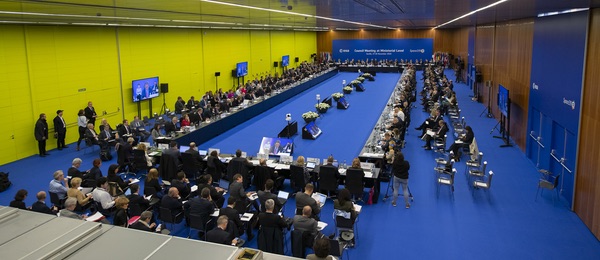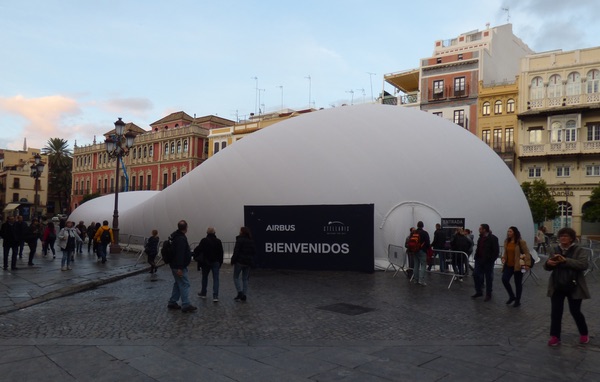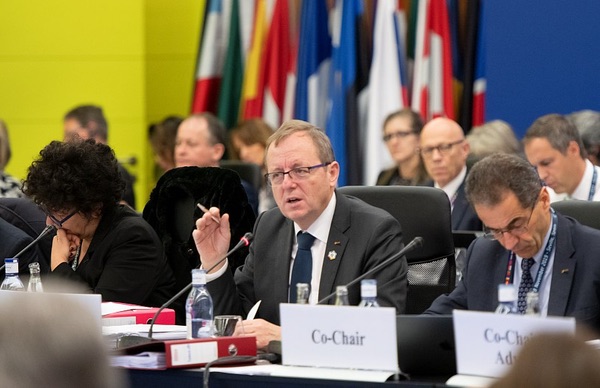Funding Europe’s space ambitionsby Jeff Foust
|
| “NASA has one government. We have 22,” Wörner said. |
The presence of this exhibit in Seville last week was no accident. While there was little, if any, explicit mention of it the exhibit, the city was host last week to the latest ministerial meeting of the European Space Agency’s 22 member states. They came to the city for a two-day meeting to make final decisions on the agency’s budget for the next three years (or, for some programs, five years.) The meeting would make, or break, ESA’s plans for everything from participation in NASA’s lunar Gateway to a proposed asteroid mission.
ESA’s funding model is very different from NASA, with both strengths and challenges. Perhaps the biggest strength is the multi-year funding that members agree to at ministerial meetings like this, roughly every three years. While NASA is funded on an annual basis, resulting in seemingly perpetual debates and uncertainty about the status of some programs, ESA has the assurance of three or more years of funding for its programs.
The disadvantage is that the process of deciding what gets funded and by how much can be byzantine. While some programs are mandatory—each member state contributes a set amount, based on its GDP—many others are optional, in that countries can decide to participate, or not, at whatever level. “These are really complicated procedures,” said Jan Wörner, director general of ESA, at the end of the ministerial meeting Thursday. “NASA has one government. We have 22.”
That means planning for the meeting, which ESA called Space19+, started long before the ministers gathered in Seville, and not long after the previous ministerial meeting in late 2016. “We started the preparation something like two years ago, which sounds long,” Wörner said during an interview during the International Astronautical Congress (IAC) in Washington in October. “But it was important to me because, after that [2016] ministerial, you know what is going on and it’s the best place to think about what is missing for the future.”
As part of that planning, ESA organized its activities into four “pillars” that officials thought best explained them to both its member states and the public. “Science and exploration” covered robotic space science missions and human spaceflight activities, including cooperation with NASA on Artemis. “Applications” included programs like Earth observation and telecommunications. “Enabling and support” features space transportation and technology development. “Safety and security,” a new area, features work on topics from space weather to planetary defense and space debris.
ESA then worked on a budget proposal for programs that fit into those four pillars, with a total value of €12.5 billion (US$13.8 billion) over three years. (The total increases to €14.3 billion, or $15.8 billion, for programs like science and basic activities whose mandatory funding is committed for five years.) That was roughly a 10 percent annual increase from the previous three-year period.
The budget proposal included many programs that, while not mandatory, were almost certain to be funded: continuation of operations of the International Space Station, production of additional service modules for the Orion spacecraft, participation in a joint Mars sample return effort with NASA, and continued development of new Earth observation satellites.
Others, though, were less certain. In 2016, ESA failed to win funding for the Asteroid Intercept Mission (AIM), a spacecraft that would have flown to the near Earth asteroid Didymos and observed NASA’s Double Asteroid Redirect Test (DART) spacecraft as it slammed into the small moon orbiting Didymos as a test of planetary defense technologies. ESA regrouped and developed a new concept, called Hera, for Space19+ that would visit the asteroid a few years after DART. But memories of AIM’s demise lingered, leading to significant advocacy efforts within the small planetary defense community to win support for the mission.
| Wörner claimed that NASA’s decision to move up the human return to the Moon to 2024 didn’t affect ESA’s plans. “It’s just that the Americans have decided to have two Americans on the surface of the Moon in 2024. That’s a national decision.” |
ESA also sought to play a larger role in Artemis with the budget proposal. The agency sought funding to start work on two modules, a telecommunications and refueling element called European System Providing Refueling, Infrastructure and Telecommunications (ESPIRIT) and an international habitation, or “iHab,” module in partnership with Japan. The agency also requested funding to begin work on a robotic lander called the European Large Logistics Lander that could be used to transport up to one and a half tons of cargo to the lunar surface and potentially be part of a lunar sample return capability in cooperation with Canada and Japan.
Wörner, in the interview at IAC, claimed that NASA’s decision to move up the human return to the Moon to 2024, deferring some work on the Gateway until later in the decade, didn’t affect ESA’s plans. “It’s just that the Americans have decided to have two Americans on the surface of the Moon in 2024. That’s a national decision,” he said. “For us, it’s fine, but as I said, we are a stable partner, so if we decide to support, we do support for a long period.”
In that interview, he said he was “really optimistic” that ESA would get most, if not all, of what it was asking for in the budget proposal in part because of extensive discussions with the member states over the last two years.
“We’ve had already several discussions with the member states about all of these programs, and there is not a single program where the member states said, ‘Oh, this is a bad proposal,’” he said. “I asked them directly that question—they could send it to me confidentially to say to abandon this or that proposal—but there was not a single one.”
Still, the countries needed to back up that interest with euros. Most of the two-day ministerial, after a series of opening statements, took place behind closed doors, as delegations met with each other to discuss what programs they would support at what levels. “The conditions for success have been met,” said Jean-Yves Le Gall, head of the French space agency CNES, in that opening session. “It remains to turn it into reality.”
 Representatives of ESA’s 22 member states, as well as other observers, gather for the Space19+ ministerial meeting last week. (credit: ESA/S. Corvaja) |
When ESA leaders and ministers from member states emerged Thursday afternoon, they declared success. “You have a happy DG in front of you,” Wörner declared at a press conference to discuss the outcome. Member states had agreed to provide €12.45 billion ($13.79 billion) over the next three years, nearly all of what ESA asked for.
That funding, though, was not evenly distributed. Some programs, like Earth observation, were “oversubscribed”: member states committed more money than ESA requested. Earth observation got about six percent more than requested, at €2.54 billion ($2.81 billion). That oversubscription was even higher for one key aspect of Earth observation, participation in the Copernicus Earth observation system in cooperation with the European Union.
“It’s a very strong signal from ESA’s member states to Europe that, first of all, ESA is a very strong partner with the European Commission,” said Josef Aschbacher, director of ESA’s Earth observation programs, of that additional funding. The extra money, he said, would go to make the program “more robust” through efforts like new instruments for measurement of atmospheric carbon dioxide levels.
Other programs, though, got less. Space safety requested €600 million ($665 million) but got a little less than three-quarters that amount. Wörner emphasized that all the major space safety programs, including the Hera asteroid mission, would continue. However, a space weather mission to monitor the Sun from the Earth-Sun L-5 Lagrange point, which was to start development in the budget proposal, will instead focus on instrument development in the final budget.
“We intended to get more, but this is life,” he said at the press conference of the space safety shortfall. “It’s not a disaster, not at all.”
| “We have made Europe a leader in space together,” said Vidal, “and together we will be able to maintain that position and enhance it.” |
Exploration programs got nearly all the €1.98 billion ($2.19 billion) requested. That includes funding for ESPRIT, iHab, and the European Large Logistics Lander, ensuring a role for ESA in Artemis beyond its current contribution of the Orion service module. “For Europe this is extraordinary,” said David Parker, director of human and robotic exploration at ESA.
While some programs, like the L-5 space weather mission, were changed, none failed to win at least enough funding to allow them to continue. “There was not a single program which we had to stop, as last time,” Wörner said.
 The Airbus Defence and Space public exhibit, loosely tied to the ministerial meeting, in a plaza in the heart of Seville last week. (credit: J. Foust) |
At the press conference, member states credited the success on a sense of European unity. “If this is a success, it was a success in our view in terms of the consensus that was built,” said Manuel Heitor, Portuguese minister of science, technology and higher education, whose served as one of the two co-chairs of the meeting.
“We have made Europe a leader in space together,” said Frédérique Vidal, French minister of higher education, research and innovation, and the other Space19+ co-chair, “and together we will be able to maintain that position and enhance it.”
By Friday afternoon, a day after the end of the meeting, all that was left of the Airbus exhibit in the plaza was the deflated tent, ready to be packed up and head out of town. ESA officials, too, were heading out of town, but with inflated budgets, and expectations, for the three years to come.
Note: we are temporarily moderating all comments submitted to deal with a surge in spam.
